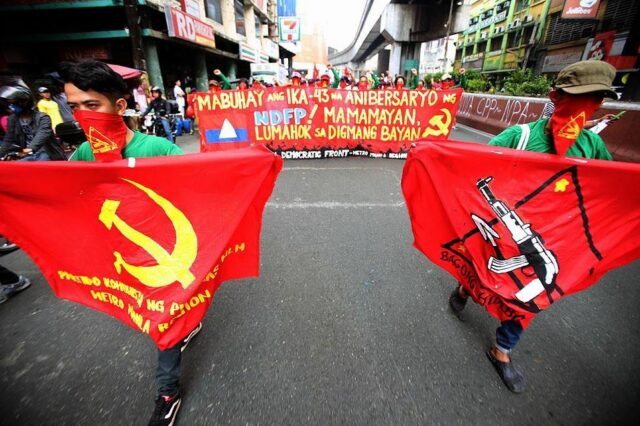
Profiling Ang Bayan: The Official Newspaper of the Philippines’ Communist Insurgency
Publication: Terrorism Monitor Volume: 20 Issue: 22
By:

The Communist Party of the Philippines-New People’s Army (CPP-NPA) is a nationwide movement comprised of a trans-provincial web of regional and local branches. To keep its leadership, fighters, and supporters up to date on the latest narratives and news developments, the group publishes a newspaper covering militant activity, political happenings, critiques of government and security force actions, and more. This CPP newspaper Ang Bayan (“The People”) has been in publication for more than 50 years and remains central to the Communist insurgent and associated activist movement in the Philippines until this day.
To reach its various linguistic target audience segments, issues are published in Filipino and then translated into Bisaya, Iloko, Hiligaynon, Waray, English, and Spanish (PRWC, 2019). The CPP, NPA, and National Democratic Front (NDF) each contribute to the bimonthly newspaper, which is released on the 7th and 21st of each month, with occasional special issues (Manila Times, September 19). The paper functions as a unifying force for the CPP’s diverse ethnolinguistic member and supporter base, while providing cues about the movement’s political and militant trajectory.
Ang Bayan’s Background
Lucia Palpal-latoc Tangi, the journalist and professor, in her history of the newspaper, wrote: “Due to the pivotal role of the press in revolutions, the Communist Party of the Philippines released its official publication Ang Bayan just months after it was re-established on December 26, 1968” (josemariasison.org, 2017). She described how the publication was founded by CPP founding chairperson Jose Maria Sison using only a few typewriters and a mimeograph machine to produce the first issue on May 1, 1969. She also noted that Ang Bayan became “the CPP’s propagandist, agitator, and organizer” and “was instrumental to establish and to maintain party unity and to popularize Marxist-Leninist-Maoist ideals.”
Ang Bayan was exclusively produced and disseminated as a physical copy until it began to be published on the NDF’s website in 1998 and then on its own website in 1999. Hard copies of the newspaper continue to be distributed mostly in parts of the countryside where there is little to no access to electricity (josemariasison.org, 2017). Further, Ang Bayan maintains a social media presence on Twitter and a tabbed section on the Philippine Revolutionary Web Portal where its past issues are archived and its new ones are posted and made available in PDF, EPUB, and MOBI formats (Twitter/@angbayan1969, November 8). The paper also accepts articles and news item submissions, and it has an interactive aspect to it with readers being encouraged to send feedback and suggestions on how to improve the publication (Ang Bayan, October 21).
In addition to its bimonthly newspaper publications, Ang Bayan produces daily news and analysis content and provides commentary on its social media accounts (PRWC, November 16). Aside from print materials, Ang Bayan also releases video and audio content (PRWC, November 7). This includes news roundups covering the most important weekly events in short two-minute video summations (Twitter/@angbayan1969, November 15). The CPP’s media, including its newspaper, is amplified by sympathetic propaganda platforms, such as Red Spark, which supports Communist rebel and dissident groups around the world ranging from Brazil to the Philippines (Red Spark, October 10, 2016).
Ang Bayan’s Critique of the Marcos Government
Naturally, the CPP-NPA has weaponized Ang Bayan to take aim at the new President of the Philippines Ferdinand Marcos Jr., his administration, and the security forces serving the new government (PRWC, November 11). The Ang Bayan media team launched a propaganda offensive against Marcos Jr. during his election campaign and has continued to critique his policies since he assumed the presidency (Ang Bayan, May 7). Just before election day, for example, Ang Bayan declared that “Democracy- and freedom-loving people are called upon to unite and take to the streets to manifest their determination to stop the return of the Marcoses to power and prevent the extension of Duterte’s reign” (Ang Bayan, May 7).
The election of Marcos Jr. was a highly galvanizing event, given how his father’s policies, and particularly his declaration of martial law in the early 1970s, helped fuel the early stage of the armed Communist rebellion in the Philippines (Twitter/@NDFevisayas, April 24, 2019). To the CPP, the Marcos family represents a political dynasty that is hostile to the interests of the Philippine people. Further, it is considered to be a powerful force backing imperialism and an anti-democratic system of governance (Militant Wire, August 16).
The CPP-NPA has since continued its laser-focused campaign to undermine and delegitimize the new Marcos government. Ang Bayan pushes narratives about the Marcos government committing war crimes, corruption, ceding sovereignty to the United States, exploiting workers, and cracking down on unions (Ang Bayan, November 7). The CPP likewise chastises the armed forces by calling them the “#1 recruiters of the NPA” due to their alleged brutality (Twitter/@prwc_info3, November 14).
Conclusion
Ang Bayan remains a pillar of the CPP-NPA’s media warfare campaign against the government, military, and police forces. The insurgent movement’s propaganda apparatus has proven durable and adaptable to all conditions, including the recently intensified pressure from the armed forces and police forces (Philippine News Agency, August 10). This is evidenced by the longevity of the newspaper and its punctuality in publishing on a bimonthly basis.
As the Philippine government and security forces seek to degrade the Communist rebels, they will most certainly target those involved with Ang Bayan’s production. This is because of how fundamentally important the publication is to keep geographically disparate Communist insurgent networks on the same page informationally and narratively. Further, the publication has been, and continues to be, a central prong in the CPP-NPA’s propaganda efforts to attack and undermine the government.




